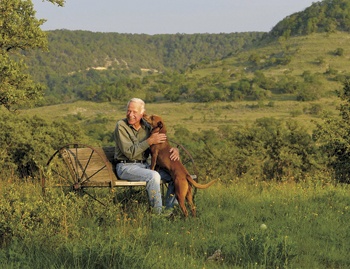J. David Bamberger begins his spiel for visitors at Selah Bamberger Ranch Preserve near Johnson City on a sobering note. He stands just outside a low cemetery wall enclosing what’s called the “tomb for mankind,” a solitary gravestone with an epitaph that warns of the Earth’s destruction if man doesn’t clean up his wastes and poisons.
You’d think you had fallen into the clutches of a doomsday tree-hugger if it weren’t for the twinkle in the rancher’s eye. But Bamberger quickly points out that he sincerely hopes the world won’t end with a whimper in wastes and poisons. He’s spent the latter half of his life assuring that his own 5,500 acres of once arid, overgrazed Hill Country does not meet such a fate.
At 81, he is as robust and charged up about his projects as the Energizer bunny. In 1969, Bamberger purchased the ranch because he wanted to see if he could make the creeks flow and the native grasses grow once more. He has spent more energy than most mortals can muster in trying to set an example of how to set mankind on a less wasteful trajectory.
One of Bamberger’s key points is that fellow landowners can follow his relatively cheap formula for reclaiming damaged ranch land. It involves eradicating invasive cedar (Ashe juniper) and sowing native grass seed. “Don’t tell me conservation is just for the rich,” he says. “Conservation is for everybody. Anybody can get grass (to grow) on the ground.”
Of course, Bamberger has means. He first made a bundle in real estate and as a distributor for Kirby vacuum cleaners in San Antonio. Then he became even wealthier as one of the original franchisers of Church’s Fried Chicken. But his interests shifted toward the natural world when he no longer had to concern himself about money. His compelling story is told in the book Water From Stone: The Story of Selah, Bamberger Ranch Preserve written by Jeffrey Greene (Texas A&M University Press, 2007). Selah is a biblical term inviting pause and reflection.
Bamberger always wanted to make a difference with his life. He expresses the belief that each individual should start something that will continue after his or her death. Even though he had no academic or agricultural credentials, he had ideas about land stewardship and improvements he wanted to explore. It took him decades to move beyond a reputation as an environmental lobbyist, but his achievements today are undisputed, and he’s taken seriously in the fields of agriculture, land conservation and even care of endangered species such as the scimitar-horned oryx bred on the ranch.
Bamberger never seems to tire of telling the story of his working ranch, whether it is to schoolchildren who are invited to spend a week there or to visiting agriculture, conservation or zoo officials. If he is accompanying a tour being led by one of his hands, he’ll usually take over the presentation. Bamberger’s enthusiasm is so catching that it’s easy to imagine his effectiveness as a vacuum cleaner salesman.
Today, his lesson for visiting journalists is simply about getting grass on the ground. He leads us over ranch land that used to regularly lose topsoil to flash floods. The land is now covered with native grasses that hold the soil in place with rainwater left over to percolate down into porous rock aquifers that replenish the creeks. (Hence the book’s poetic title, Water From Stone.)
Bamberger uses a simple prop, what he calls the “rain machine,” to provide an aha! moment for guests. The apparatus sits on the shore of Madrone Lake. Attached to a wire frame are a tray of little bluestem grass and a tray of equal size holding bare soil and a cedar sapling. Above them are separate drip containers that evenly distribute small showers to each slightly tilted tray. Under the trays are plastic containers for runoff water. In addition, in the soil of each tray are PVC pipes leading to plastic bottles that simulate groundwater.
When Bamberger starts the shower, water runs so quickly through the thin branches of the cedar sapling and its soil that the tray tips most of the moisture into the runoff container. That’s what happens when a steady rain pounds eroded, cedar-covered ranch land, causing dry creek beds to quickly rise and move the water downstream. There’s not enough root structure to retain the water on-site.
Below the other tray, however, the water is slowly absorbed by the little bluestem grass and its fibrous root system, leaving little to rush into the runoff jar. Instead, the excess moisture trickles into the groundwater jar, representing a replenishment of the water table. If there were thermometers in the two trays, Bamberger says, the tray of grass would be significantly cooler than the tray of juniper.
But the demonstration is not over. Bamberger next cradles a bundle of twined roots, holding it close to his cheek as if it were a precious infant. With a sly grin, he looks like he’s ready for his close-up. The roots are comparable to those bunched up in the little bluestem tray, he says. Spread out, the roots would cover considerable ground. That’s why the roots hold the soil so well and transfer excess moisture to the porous underground rock formations that store rainwater.
Bamberger concedes that it sometimes has been difficult to get enough native grass seed to sow on his rehabilitated property. One year he spent $20,000 purchasing most of the seed available in the state.
So maybe ordinary ranchers can’t do everything he has done. But with greater demand will come greater supply, he says. And there are workshops to help people get started reclaiming their land, including some at the Bamberger Ranch Preserve.
There’s no time on this tour for journalists to visit the countless springs on Bamberger’s reclaimed land or to look for the 178 species of birds that now inhabit the area, depending on season and migration. But both the springs and the birds have a strong chance of enduring for a long time to come.
Long may J. David Bamberger keep going and going and going.
——————–
For more information about tours and land stewardship workshops, go to www.bambergerranch.org or call (830) 868-2630. Bamberger is a private ranch, and visitation is strictly by reservation. The ranch is held in perpetuity by a nonprofit foundation.
Kaye Northcott is editor of Texas Co-op Power.


